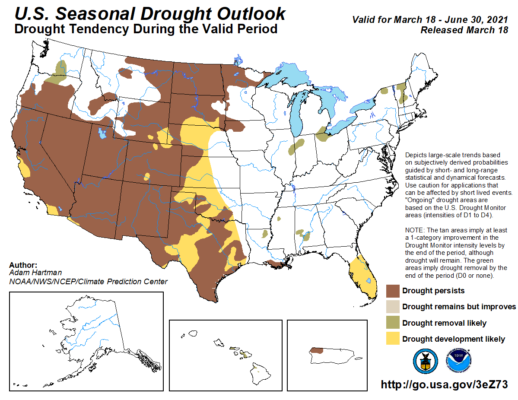
An exceptionally dry winter has brought what experts are describing as drought conditions to Los Angeles County, but officials in Pasadena say local water restrictions beyond the usual seasonal conservation efforts are not anticipated.
While the governor’s office has not issued a formal declaration of drought in the state, experts said observations indicate drought conditions have already arrived.
An analysis by the National Drought Mitigation Center placed L.A. County in the “severe drought” category as of April 6.
This is the second year dry conditions have persisted, according to Pasadena Water and Power spokeswoman Margie Otto.
“The imported water supplies provided to the Metropolitan Water District of Southern California have been reduced to levels which reflect the severe drought conditions in Northern California and the Colorado River Basin,” Otto said.
“However, investments to store water have been successful and Pasadena and MWD do not anticipate enacting any water restrictions beyond the normal conservation stages expected for each summer,” she said.
“PWP continues to seek ways to improve local groundwater storage by making capital investments such as the Arroyo Seco Canyon Project, which is needed to restore lost capacity and reduce dependency upon imported water sources,” Otto added.
Nonetheless, saving water is, and will continue to be, encouraged.
“With under six inches of rain this year, many residents have begun to irrigate earlier than normal,” Otto said. “ Now is a great time to explore water-saving alternatives for their yards and landscapes.”
Aerial photos published in the Daily Mail last week depicted a nearly empty San Gabriel Reservoir.
National Weather Service Hydrologist Jayme Laber said although political leaders have not formally declared a drought situation in California, the observations speak for themselves.
“The governor usually declares a drought for the state of California or portions of the state of California. That has not happened, so there’s no officially declared drought. But if you look at drought indicators…we have been below normal rainfall this water year,” Laber said.
“From Oct. 1 of last year through now we are running in Los Angeles County about 20 to 40% of normal rainfall,” Laber explained. “So when you start looking at things like that, we’re definitely below normal. And even though the governor hasn’t officially declared a drought, we are certainly in conditions where I would say that we’re definitely drier than normal and we’re trending toward drought.”
Most of the region’s rainfall tends to come during the first three months of the calendar year, he said.
“In January, we did have some pretty good storms. We had some rainfall. We had some snowfall in the mountains, so January wasn’t too bad,” Laber said. “But [in] February, we hardly had any rainfall or snow at all. And March has been below normal as well.”
The scientist said recurring dry periods are a natural cycle in Southern California. “It’s not unusual for us to have these kinds of drought periods and then we’ll have some wet periods. That’s pretty normal. It’s pretty dry, though, this year,” he said.
“When you start stringing three to four years together, that’s when we’d start getting fairly critical… That’s where we’ll start having water rationing if it gets there,” Laber said. “But at this point, where we’re at right now, there’s enough reserve where we can withstand and get through a dry year like this. But if we start stringing them together, that’s where it gets more critical.”
JT Reager, a hydrologist at NASA’s Jet Propulsion Laboratory, concurred.
“We live in a dry region where there is a lot of variability in the amount of precipitation that comes,” Reager said. “In California, we get about half of our precipitation in just like four or five events per year. So if we don’t get one of those events or two of those events, all of a sudden we’re down to like 60% of our normal precipitation. So we live in a very, very sensitive area, and in any given year we can have a drought crop up. And if we have a couple of dry years in a row, then we really get this dry condition.”
Snowmelt in the mountains has been occurring earlier and earlier in recent years, according to Reager.
“When we have earlier snowmelt, we get less water in the reservoirs,” he said.
“Looking forward into the summer, into the fall, we know that those dry conditions are going to create a future lack of water that’s really going to hit us hard in the summer and fall when we need the water the most,” Reager said.
There remained hope that April would still hold more rain for the Southland. “But if we don’t get any more rain or snow, it’s going to be a long summer,” he said.
“The best practice is good monitoring,” Reagan added. “In order to make good decisions about something, you have to have good information. And that’s what we try to do at NASA, is give you the observations so that we have good information.”
Pasadena’s former Non-Potable Water Program, first proposed in 2017 and meant to seek recycled water and other non-drinkable sources for irrigation and industrial purposes, is no longer being pursued, according to Otto.
“Pasadena has suspended work on the former non-potable project concept which was dependent upon imported recycled water, and is working in collaboration with neighboring agencies for more viable options,” she said.
“PWP also works closely with the city’s Fire Department to help residents get educated and the importance of brush clearance and has improved the brush clearing and vegetation management on the large spaces in the watershed owned and maintained by the water utility,” Otto said.
More information on water conservation from the PWP can be found online at PWPweb.com/savewater.


















